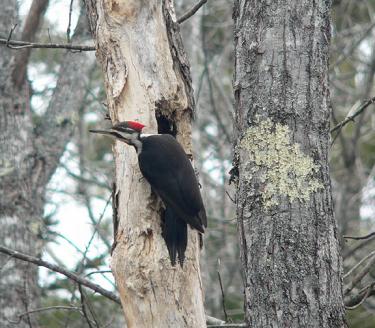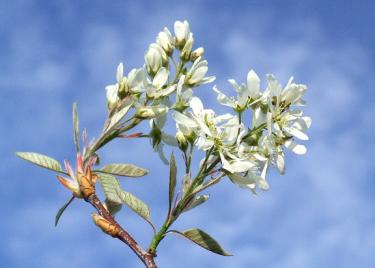Create a Healthy Bird Habitat
Species like this pileated woodpecker use dead trees for food and shelter.
Working toward a healthy, bird-friendly forest means supporting all levels of woodland growth—herbaceous, shrub, sub-canopy and canopy. Birds rely on every part of the forest for important resources. And because different birds rely on different parts of the woods, ensuring the health of all layers of the forest will help draw a diverse community of birds.
- Maintain a consistent, unbrokent, multi-story habitat that birds can rely on. When cutting trees, practice single-tree removal or limit sections of tree removal to 1.25 acres at most. Retaining clusters of over-story trees will help provide continuous habitat for birds. Increase the area of unbroken forest in your woods by eliminating unused roads and other openings that break up the canopy and diminish habitat value for forest-dwelling birds. Also plant groundcover, bushes and under-story trees to birds that frequent the lower forest will have plenty of cover.
- Plan management activities by season. Forest management activities will impact birds, but you can minimize that impact by trimming and cutting trees outside of the breeding season, which typically runs from early spring to late summer. By giving breeding birds a chance to hatch, rear and fledge their young, you will give them a better chance for breeding success and encourage them to consider your woods a safe place to live.
- Leave deadwood and brush piles. In a natural forest, nobody is out clearing the old trees and shrubs. Because of this, many birds have grown to rely on deadwood. An average of 40 species in a given forest use dead trees and logs for perches and cover, as well as an important source of bugs and other critters that birds like to eat. So if you can, let it lie. Note: If you are concerned about the safety of leaving snags on your land, consult a forester about the best way to retain deadwood.
Birds love berry, seed, and nut trees like this serviceberry.
- Plant food trees. Berry, seed and nut trees are very important for birds. Native plant species like serviceberry, black cherry, beech and oak are particularly bird-friendly because they provide fruit and seeds, support bug, spider and insect communities, and create safe spaces for birds to hide from predators. Fruit and nut trees will thrive with some care, and the healthier they are, the more resources they provide for wildlife.
- Minimize the negative impacts of edge habitat and accentuate the positive. Edge habitat is where a forest transitions into a field and it can be a very productive area with many diverse species of birds. But it can be dangerous for some birds, particularly if the change is abrupt. Predators like domesticated cats, non-native birds and raccoons have an advantage when the forest opens abruptly. You can minimize negative impacts of abrupt edge habitat by maintaining a circular or square-shaped forest. Where edges exist, make a transition zone by planting trees sparsely on the forest edge and encouraging the growth of thickets of fruit-bearing native shrubs. You can also cut trees selectively to soften the edge and encourage the growth of thickets. Consider adding nest boxes at your softened forest edge to encourage birds like bluebirds and screech owls to inhabit the enhanced edge.
Previous page
Next page
How can I get more tips?
It’s simple! Enter your email below.


